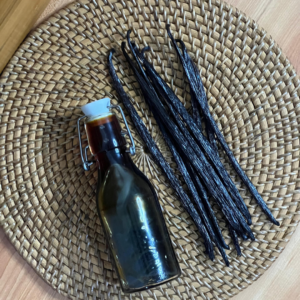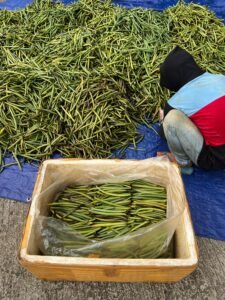Indonesia’s vanilla beans are celebrated globally for their rich aroma, robust flavor, and sustainable cultivation methods. Grown in Indonesia’s lush landscapes, these premium beans undergo a meticulous process that transforms them from delicate orchid blossoms into one of the world’s most sought-after flavoring ingredients. With its rising role in the global vanilla market, Indonesia offers exciting opportunities for farmers and exporters alike. This article explores the story of Indonesia’s vanilla—from its heritage roots to its expanding global legacy.

The Cultivation Journey: Growing and Harvesting Indonesia Vanilla
Indonesia’s tropical climate and fertile soil provide the perfect environment for cultivating vanilla orchids. Farmers carefully nurture the plants, often adopting organic farming practices to ensure premium beans. The process begins with hand-pollination—a skillful, labor-intensive method requiring precision and care.
After pollination, vanilla pods grow for several months before being harvested. Experienced farmers, using generational knowledge, determine the optimal harvest time to ensure full flavor development and maximize quality.
Curing Techniques: Unlocking Indonesia Vanilla’s Signature Flavor

Once harvested, the beans undergo a multi-step curing process to enhance their aroma and flavor. This process involves sweating to release moisture, sun-drying to intensify the taste, and aging to deepen the aroma. Each step is essential to producing the premium black vanilla beans that distinguish Indonesia’s offerings in the global market.
Transforming Beans into Premium Vanilla Extract
Indonesia is also recognized for producing high-quality vanilla extract. The process starts with slicing and soaking cured beans in alcohol to extract their essence. Advanced extraction methods, combined with stringent quality controls, ensure the final product meets the highest global standards.
Producers increasingly focus on sustainable and organic production methods, further enhancing the global reputation of Indonesian vanilla extracts and meeting consumer demands for ethical sourcing.
Packaging for Global Markets: Ensuring Freshness and Quality
To ensure vanilla beans and extracts reach global markets in prime condition, exporters follow strict packaging standards. These methods preserve product freshness and quality during transit.
Innovative solutions, such as vacuum-sealing and eco-friendly materials, appeal to global buyers who prioritize product quality and sustainability, further positioning Indonesia vanilla as a premium product.
Sustainability: A Key Driver of Indonesia’s Vanilla Industry
Sustainability is central to Indonesia’s vanilla industry. Many farmers adopt practices that promote biodiversity, reduce chemical use, and ensure fair wages. These efforts protect the environment and enhance Indonesia’s reputation as a responsible producer of premium vanilla.
Certifications like organic and fair trade add further value as international consumers increasingly seek ethically and sustainably sourced products. These efforts strengthen Indonesia’s position as a leading supplier of premium vanilla on the global stage.
Conclusion: Indonesia Vanilla Beans’ Growing Global Legacy
From farm to flavor, Indonesia vanilla beans undergo a meticulous transformation to become a beloved ingredient in kitchens and industries worldwide. This journey highlights the dedication of local farmers, the richness of Indonesia’s environment, and the nation’s commitment to sustainable practices. Whether enjoyed as whole beans or as premium vanilla extract, Indonesia vanilla symbolizes unmatched quality and taste. As global demand continues to grow, Indonesia is poised to become a leading force in the international vanilla market, solidifying its legacy as a global treasure.
If you’re interested in learning more about Indonesia’s premium vanilla beans, their unique qualities, or how to source them, we’re here to help. Contact us today for more information on how Indonesia’s vanilla can elevate your products and meet global market demands.
People Also Ask: Indonesia Vanilla Beans and Their Global Journey
- What makes Indonesia vanilla beans unique? Indonesia vanilla beans are known for their rich aroma and robust flavor. The tropical climate, fertile soil, and traditional farming methods contribute to their distinctive taste.
- How is vanilla grown in Indonesia? Vanilla orchids are hand-pollinated and carefully nurtured by local farmers. After several months of growth, the beans are harvested at peak maturity to ensure the best flavor.
- How long does it take to grow and process vanilla? It takes approximately 3-4 years for a vanilla vine to produce its first harvestable pods. After harvesting, the curing and conditioning process can take several months to develop the bean’s characteristic flavor and aroma.
- How is vanilla extract made in Indonesia? Vanilla extract is made by slicing and soaking cured beans in alcohol to extract the essence. Advanced extraction methods and strict quality controls ensure a high-quality product. For halal-certified products, producers use alcohol derived from permissible sources to meet halal compliance standards. This ensures the extract can be enjoyed by consumers seeking halal-friendly options without compromising on quality.
- Why is sustainability important in the Indonesia vanilla industry? Sustainable practices help protect the environment and improve the livelihoods of farmers. Many producers are adopting organic methods and fair trade practices to meet global demand for ethically sourced products.
- What are the export opportunities for Indonesia vanilla? Indonesia’s vanilla industry is expanding in the global market due to its premium quality and sustainability efforts. High-quality packaging and adherence to international standards further enhance export opportunities.
- How does Indonesia ensure the quality of its vanilla for export? Strict quality control measures, vacuum-sealing, and eco-friendly packaging help preserve freshness and ensure the beans and extracts reach international markets in prime condition.


